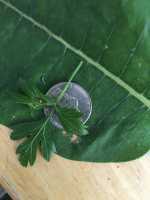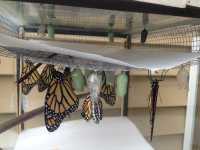Monarch Butterfly Life Cycle (FROM [monarchwatch.org]
All insects change in form as they grow; this process is called metamorphosis. There are two kinds of metamorphosis, incomplete (or simple) metamorphosis, and complete metamorphosis. An example of incomplete metamorphosis is found in grasshoppers. The young nymphs usually look much like small wingless adults. The wings develop externally, and there is no prolonged immobile (pupal) stage. Butterflies and moths undergo complete metamorphosis, in which there are four distinct stages: egg, larva (caterpillar), pupa, and adult.
Monarch development from egg to adult is completed in about 30 days.
Egg (3-4 days)
Monarchs usually lay a single egg on a plant, often on the bottom of a leaf near the top of the plant. It is difficult to tell just how many eggs each female lays during her life, but the average is probably from 100 to 300. The eggs hatch about four days after they are laid.
Approximate dimensions: 1.2mm high; 0.9mm wide
Larva (Caterpillar; 10-14 days)
It is during this stage that Monarchs do all of their growing. They begin life by eating their eggshell and then move on to the plant on which they were laid.
When the caterpillar has become too large for its skin, it molts or sheds its skin. At first, the new skin is very soft and provides little support or protection. The new skin soon hardens and molds itself to the caterpillar, which often eats the shed skin before starting in anew on plant food! The intervals between molts are called instars. Monarchs go through five instars (see photo). Approximate length of the body at each stage: 1st instar, 2-6mm; 2nd instar, 6-9mm; 3rd instar, 10-14mm; 4th instar, 13-25mm; 5th instar, 25-45mm.
Pupa (Chrysalis; 10-14 days)
During the pupal stage, the transformation from larva to adult is completed. Pupae are much less mobile than larvae or adults, but they often exhibit sudden movements if they are disturbed. Like other butterflies, Monarch pupae are well-camouflaged, since they have no other means of defense against predators.
Adult
The primary job of the adult stage is to reproduce - to mate and lay the eggs that will become the next generation.
Females begin laying eggs right after their first mating, and both sexes will mate several times during their lives. Adults in summer generations live from two to five weeks. Each year, the final generation of Monarchs, which emerges in late summer and early fall, has an additional job: to migrate to their overwintering grounds, either in central Mexico for eastern Monarchs or in California for western Monarchs. Here they survive the long winter until conditions in the United States allow them to return to reproduce. These adults can live up to eight or nine months.
Male and female Monarchs can be distinguished easily. Males have a black spot (see photo) on a vein on each hind wing that is not present on the female. These spots are made of specialized scales which produce a chemical used during courtship in many species of butterflies and moths, although such a chemical does not seem to be important in Monarch courtship. The ends of the abdomens are also different in males and females, and females often look darker than males and have wider veins on their wings.
No growth occurs in the adult stage, but Monarchs need to obtain nourishment to maintain their body and fuel it for flight. Nectar from flowers, which is about 20% sugar, provides most of their adult food. Monarchs are not very picky about the source of their nectar and will visit many different flowers. They use their vision to find flowers, but once they land on a potential food source, they use taste receptors on their feet to find the nectar.
The above article is from the website: [monarchwatch.org]
Except for the generation that migrates to Mexico or Southern California, an adult monarch lives from 4 to 6 weeks. During that time the female lays more than 100 eggs by "tagging" the underside of milkweed leaves laying one single egg at a time. She may stay in the same area and lay several eggs on several different plants. The picture in the above article shows a greatly enlarged egg. Actual size is not much bigger than the period at the end of this sentence. A tiny caterpillar emerges after three or four days.
It takes 10 to 14 days for the caterpillar (larva) to reach its full size. At that time, it finds a place where it secretes a glue-like substance and hangs down in the form of the letter "J" and in a couple of hours begins to transform to the next phase which is the chrysalis (pupa).
It takes another 10 to 14 days for the full-grown adult monarch to emerge from the chrysalis. At the time it emerges its torso is very large. It takes about an hour for the butterfly to be ready to take flight.
Attached are two photographs I took last year. The first shows the size of the newly emerged caterpillar. The second one shows chrysalises and butterflies in my ...

Enjoy being online again!
Welcome to the community of good people who base their values on evidence and appreciate civil discourse - the social network you will enjoy.Create your free account
4 comments
Feel free to reply to any comment by clicking the "Reply" button.I like the part about the imaginal bodies, stable points within the pupa that the new butterfly will form around after the caterpillar has melted down into protoplasmic soup. It made me wonder if some of us function as Society's imaginal bodies during times of chaos.
While Googling for that term (out of use and hard to find now), I came across a new-to-me organization founded by a hunger activist that I'd known in another time and place. The Pachamama Alliance had responded to a Shaman's call to help the Achuar tribe to preserve rights to their traditional lands along the Amazon. They had an activist training program, but I declined to join because I could not accept one of the presuppositions: that we live in a benevolent universe. Hard to hold onto that one, after so many of the people I loved have suffered and died. I'm not impressed by this "wondrous" aging process, either! My own views are best expressed in the book entitled Mother Nature Is Trying to Kill You!
Recent Visitors 11
TerriCity
FL, USA
JenBeberstein
CA, USA
MikeEC
Hot Springs National Park,
Geni47
Canada
Leafhead
WI, USA
Photos 104 More
Posted by TerriCitySulpher butterfly from caterpillar to pupa to adult butterfly.
Posted by TerriCitySulpher butterfly from caterpillar to pupa to adult butterfly.
Posted by TerriCitySulpher butterfly from caterpillar to pupa to adult butterfly.
Posted by TerriCitySulpher butterfly from caterpillar to pupa to adult butterfly.
Posted by LeafheadAsclepias sullivantii, the Sullivant's Prairie Milkweed. Taken at a way station in Middleton, WI
Posted by LeafheadCeropegia woodii Hoya carnosa Both plants bloom at night and attract lots of cool moths
Posted by LeafheadCeropegia woodii Hoya carnosa Both plants bloom at night and attract lots of cool moths
Posted by DAB456What kind is this? I think I know, but would like another opinion.
Posted by bigpawbulletsNot sure what these guys are. But suddenly we seem to be getting a few of them in the "Habitat":
Posted by bigpawbulletsSilly meme. But an attractive butterfly. Photoshopped or real?
Posted by MikeECI posted this earlier In the Gardeners group, but had actually intended to post it here. Those of you who are members of both groups get to see it twice ?
Posted by MikeECI posted this earlier In the Gardeners group, but had actually intended to post it here. Those of you who are members of both groups get to see it twice ?
Posted by LeafheadMy latest visitor to the feeder, a Hackberry Emperor
Posted by MikeECI managed to overwinter three Eastern black swallowtail chrysalises in my unheated garage and released them about a month ago.
Posted by MikeECI managed to overwinter three Eastern black swallowtail chrysalises in my unheated garage and released them about a month ago.
Posted by MikeECI managed to overwinter three Eastern black swallowtail chrysalises in my unheated garage and released them about a month ago.








